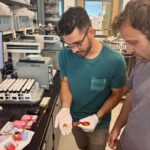
A notable increase in battery-related fire incidents has prompted urgent discussions about battery safety and the latent defects that could lead to catastrophic malfunctions. These issues often remain undetected until it is too late, posing a potential threat not only to individual consumers but also to industries relying increasingly on lithium-ion batteries. Researchers at Drexel University have stepped into this precarious landscape with innovative technology aimed at enhancing the safety and reliability of battery production.
In a groundbreaking paper recently published in the journal Electrochimica Acta, Drexel’s research team introduced a novel ultrasonic testing methodology that promises to revolutionize how manufacturers evaluate the integrity of batteries. This technique is designed to scrutinize the electrochemical and mechanical functions of batteries, effectively identifying any damage or flaws that may lead to overheating and the dreaded phenomenon known as “thermal runaway.” This catastrophic event has been known to result in battery fires, explosions, and even widespread recalls of consumer electronics.
Dr. Wes Chang, a pivotal member of the research team and an assistant professor at Drexel University, emphasized the importance of this innovative approach. “Despite lithium-ion batteries having been in existence for nearly fifty years, our understanding of their internal structures remains limited. The techniques we have developed offer a high-resolution view into battery internals, making it possible to detect issues before they escalate into serious problems,” he remarked. The adaptation of ultrasound technology, traditionally utilized in fields such as geophysics and biomedical sciences, offers a fresh perspective on battery diagnostics. Its introduction to the battery industry within the last decade is a game-changer that could have far-reaching implications on battery safety.
.adsslot_bY2ywQXu9M{ width:728px !important; height:90px !important; }
@media (max-width:1199px) { .adsslot_bY2ywQXu9M{ width:468px !important; height:60px !important; } }
@media (max-width:767px) { .adsslot_bY2ywQXu9M{ width:320px !important; height:50px !important; } }
ADVERTISEMENT
The team has crafted an accessible benchtop ultrasonic tool, aimed at empowering battery engineers with the capacity to conduct rapid assessments of battery integrity. This advancement seeks to bridge a gap in battery manufacturing, particularly amid a backdrop of increased demand for various electronic devices powered by lithium-ion cells. Reports indicate that the average individual uses three to four battery-operated devices daily, a trend that has doubled in the past five years. The rush to meet this soaring demand often compromises quality control, resulting in subpar battery production processes.
“While the majority of lithium-ion batteries on the market today are safe and efficient, the overwhelming production numbers raise the specter of defects slipping through the cracks. When thousands of cells are deployed in electric vehicles, even a minuscule manufacturing flaw can propagate and affect an extensive array of batteries,” Dr. Chang cautioned. Current safety protocols, rooted in visual inspection and selective performance testing, prove insufficient in identifying potential hazards. Though some manufacturers employ X-ray imaging to scrutinize battery architecture, this method faces criticisms for being time-consuming and expensive.
Recognizing the urgent need for enhanced quality control, the Drexel team’s ultrasonic approach presents a swifter, cost-effective alternative. Their methodology harnesses acoustic imaging technology, employing ultrasound waves that traverse the various materials found inside a commercial pouch cell battery. This process analyzes how the sound waves behave within the structure, providing valuable insights into its chemical changes and mechanical performance without disrupting the cell’s functions.
By observing alterations in sound wave transmission, researchers can infer an array of structural features within the battery, thus pinpointing precise areas of stress, defects, or even gas accumulation—a critical indicator of battery health that could herald potential failure. The ultrasound technique’s sensitivity further extends its application beyond mere manufacturing defects; it proves invaluable during the materials discovery phase in research and development labs.
In collaboration with SES AI, a burgeoning lithium metal battery startup, Chang and his team realized the practical applications of this technology in real-time settings. By integrating this ultrasonic system within SES AI’s research facility, engineers benefit from immediate access to diagnostic data during the design and testing phases, fostering rapid iterations and improvements in battery designs.
In addition to reporting on the practical techniques for battery testing, Drexel’s team also developed open-source software to facilitate the use of their ultrasonic tool. This user-friendly interface streamlines data analysis, allowing researchers to focus on improving battery technology rather than grappling with complex instrumentation. “Our aim is to make ultrasonic testing a routine part of battery research and engineering,” Chang added, reiterating the accessibility of this technology for a new generation of battery scientists intent on enhancing safety and performance.
Looking forward, the research group is committed to continually refining their techniques, aspiring to enhance the capability of ultrasound to produce detailed, three-dimensional scans of battery electrodes and cells. These advancements could offer an even clearer perspective on defects, allowing manufacturers to preemptively address critical issues and improve overall battery performance.
The significance of this research extends beyond academia and into practical applications that could reshape consumer electronics and electric vehicles. As the global market for battery-powered devices expands, the implications of increased battery safety and quality assurance have never been more pertinent. The Drexel University team’s pioneering efforts highlight the ongoing need for innovation in battery technology, aligning with broader trends toward cleaner energy and sustainable practices in transportation and beyond.
With their recent findings, the Drexel researchers are not just aiming to prevent battery fires but are also steering the conversation toward making lithium-ion batteries safer and more reliable for consumers everywhere. Their work marks a critical step in addressing the unique challenges posed by contemporary battery applications, underscoring the necessity of evolving quality assurance methods in line with automotive and technological advancements.
Ultimately, as industries increasingly pivot toward battery-driven solutions, the integration of advanced testing methods like ultrasound may well prove essential for ensuring the integrity and safety of the very devices that power our modern lives.
Subject of Research: Ultrasonic testing for battery safety and quality control
Article Title: Design of a low-cost ultrasonic testing instrument for battery metrology
News Publication Date: 1-Jun-2025
Web References: https://www.nytimes.com/2025/01/28/world/asia/busan-plane-fire-south-korea.html, https://www.inquirer.com/transportation/septa-bus-fire-preliminary-investigation-20250606.html?query=bus%20fire, https://www.sciencedirect.com/science/article/pii/S0013468625003755, https://www.theverge.com/2018/8/13/17675376/battery-safety-lithium-ion-solid-state-electrolyte-analysis, https://www.consumeraffairs.com/cell_phones/cell-phone-statistics.html, https://vimeo.com/1090093086, https://www.theverge.com/2016/9/2/12777320/samsung-galaxy-note-7-recall-battery-explosion, https://www.ses.ai/
References: N/A
Image Credits: N/A
Keywords
Tags: battery integrity evaluationbattery safety technologybattery-related fire incidentsconsumer electronics safetyDrexel University researchelectrochemical function analysisidentifying battery defectsinnovative battery production techniqueslithium-ion battery testingmechanical function scrutinythermal runaway preventionultrasonic testing methodology



